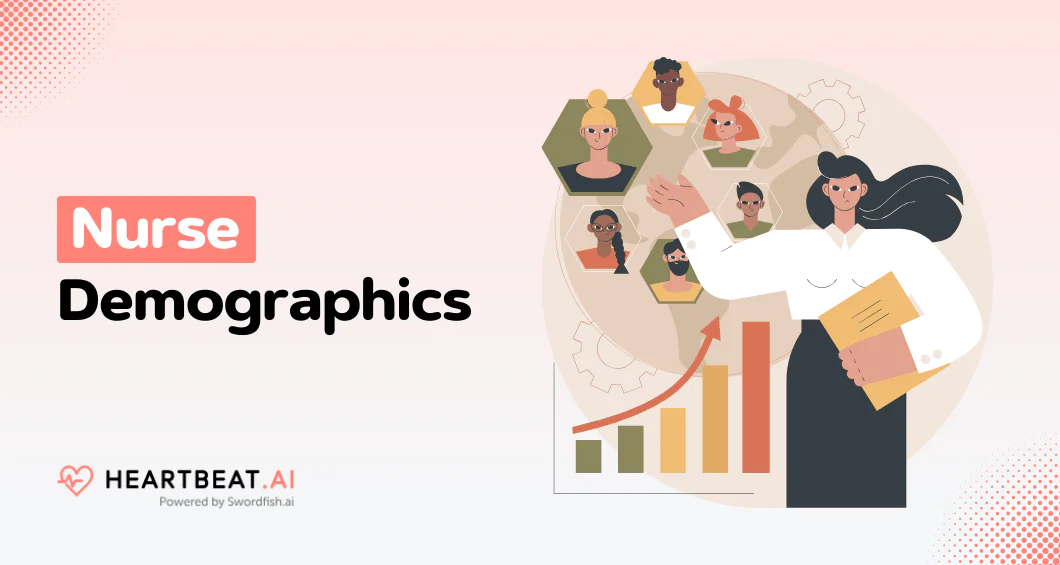
Do you know that there are over 3,041,281 nurses currently employed in the United States? It’s quite a surprising number, isn’t it? But these figures are just the beginning. Nurse demographics go beyond statistics; they are a window into the heart of healthcare.
In this guide, we’ll take you on a journey through the demographics of nurses in 2024. We’ll uncover how these numbers provide a basis for understanding communities as they are now, where they’ve been, and where they’re headed.
We’ll look into the total number of nurses in the USA, their gender distribution, age demographics, salaries, and much more. So, whether you’re a healthcare professional or simply curious about the state of nursing, read on.
What’s on this page:
Nurse Demographics And Statistics: A Quick Overview

Nurses are important healthcare professionals in the USA, with a diverse and dynamic workforce. Here’s a quick overview of nurse demographics and statistics:
Total Nurses Employed: Over 3,041,281 nurses are currently employed.
Gender Distribution:
- Predominantly female workforce.
- Men represent approximately 12% of the nursing workforce.
Average Age: The average age of registered nurses is 47 years.
Ethnicity & Racial Composition:
- White: 69.6%
- Black or African American: 11.4%
- Hispanic: 8.8%
- Asian: 7.9%
- Other races: Includes Multiracial, American Indian, and others.
Educational Background:
- A significant portion begins their career with a Bachelor’s degree.
- 14.9% hold a Master’s degree.
- 2.2% have a Doctorate.
Annual Job Openings: Over 200,000 RN jobs projected annually from 2021 to 2031.
Job Satisfaction: 81% of nurses report satisfaction with their work.
Growth Projection: The nursing profession is expected to grow by 9% from 2020 to 2030.
Median Salary: Nurses have experienced a median salary of over $75,000 since early 2020.
Salary Disparities:
- Variations exist among different racial and ethnic groups.
- Asian nurses earn the highest average salary, while Black nurses earn the lowest.
How Many Nurses are Currently Practicing in the United States?
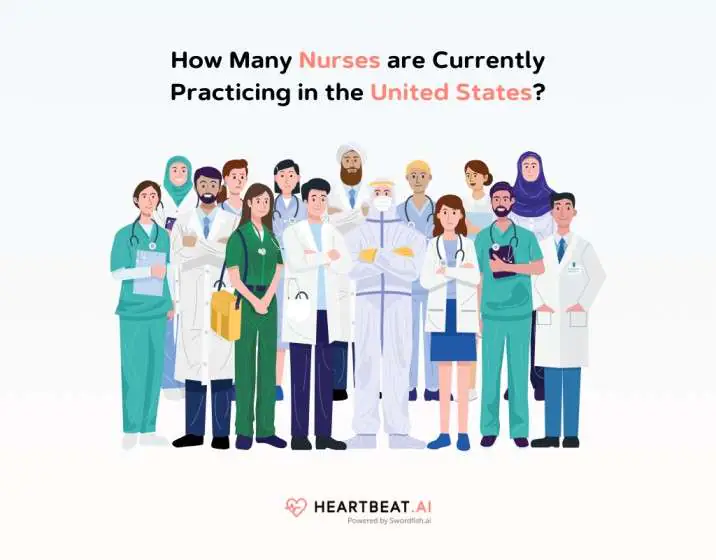
As of 2023, the United States has approximately 4.42 million Registered Nurses (RNs) and over 700,000 Licensed Practical Nurses (LPNs). This strong workforce of nursing professionals plays an important role in the healthcare industry.
The nursing profession in the U.S. plays a crucial role in healthcare, with a vast and varied workforce of nurses committed to patient care in various settings. Current data show a significant number of nurses are in practice, highlighting the profession’s expansion and the rising need for nursing services.
RNs, having undergone extensive training, play a key role in patient care, education, and advocacy. LPNs complement this care, focusing on monitoring patients, administering medications, and helping with daily activities, all under the guidance of RNs and doctors.
The profession is growing due to an aging population, healthcare expansion, and medical technology advancements. Despite facing workforce shortages and challenges, nursing is becoming more diverse and inclusive, improving healthcare quality and accessibility.
With competitive salaries and numerous advancement opportunities, nursing offers a variety of specialties, showcasing its adaptability and dedication to evolving healthcare needs.
What Percent of Nurses are Female?

In the United States, a significant majority of nurses are female, with approximately 87% of the nursing workforce being women. This statistic underscores the significant gender disparity within the nursing profession, reflecting long-standing trends in healthcare occupations.
Nursing has historically been a profession dominated by women, and this trend continues today in the United States. The figure of about 87% illustrates that a vast majority of nurses are female, reflecting both historical trends and current societal norms regarding caregiving roles.
This percentage points to the gendered nature of nursing, where women have been the primary caregivers in both professional settings and at home.
The origins of this trend can be traced back to the days of Florence Nightingale, who is often credited with founding modern nursing. Nightingale’s work during the Crimean War and her establishment of nursing as a formal profession paved the way for women to enter the field in large numbers.
Over time, nursing has evolved, but it has remained strongly associated with women, both in terms of workforce composition and societal expectations.
Despite the overwhelming presence of women in nursing, there’s a growing awareness of the need for gender diversity within the profession. Men are being encouraged to join nursing, both to alleviate the nursing shortage and to diversify perspectives and skills in the field.
What Percent of Nurses are Male?

Male nurses represent approximately 12% of the nursing workforce in the United States. This percentage reflects a gradual increase over the years, highlighting a slowly diversifying profession.
Historically, nursing has been mostly female, but recent decades have seen a shift towards more gender diversity within the field. Approximately 12% of registered nurses (RNs) in the U.S. are male, according to data from the U.S. Bureau of Labor Statistics and various nursing organizations.
This growth reflects changing perceptions of gender roles in healthcare and efforts to promote nursing as a viable and rewarding career option for men. Male nurses bring valuable perspectives and diversity to the healthcare team, enhancing patient care and challenging traditional gender norms in the profession.
The increase in male nurses is also seen as a positive step towards addressing the overall nursing shortage, as it widens the pool of potential nurses.
What is the Average Age of Nurse?
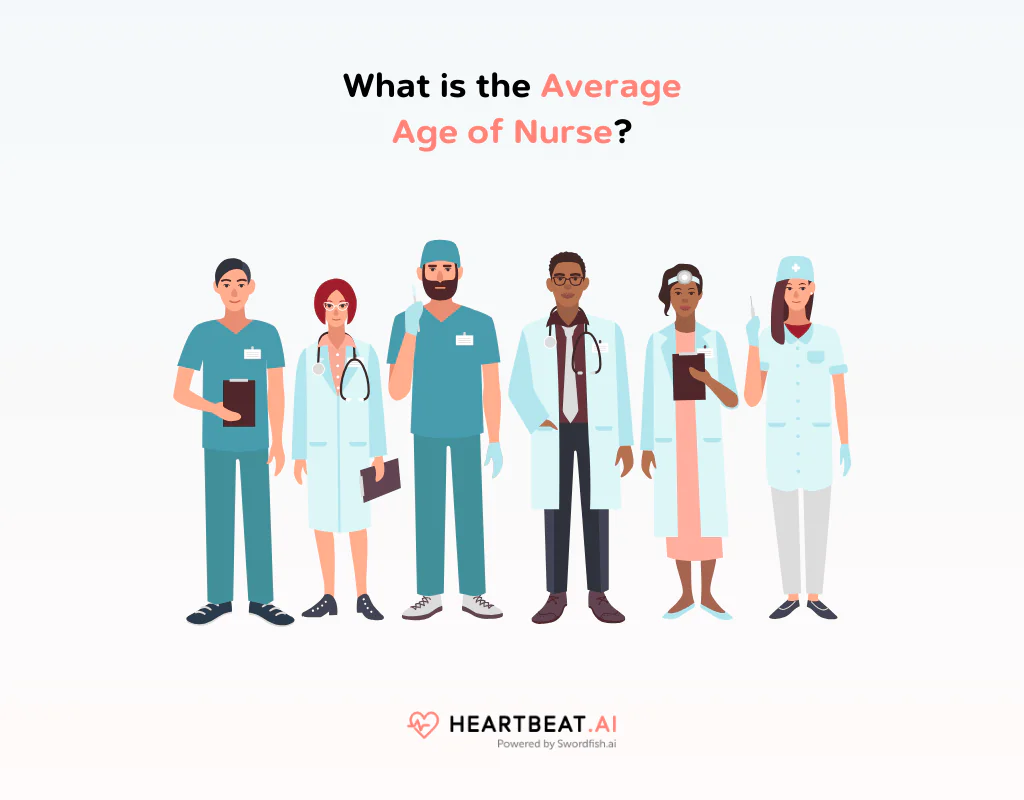
The average age of nurses in the United States is approximately 47 years, reflecting a growing need for younger nurses to enter the profession.
This statistic points to a significant trend within the nursing profession – an aging workforce.
Over the years, the field of nursing has indeed witnessed a growth in older nurses. This has subsequently raised concerns regarding succession planning and the imperative need for younger nurses to join the workforce. Several factors contribute to this trend.
Firstly, many nurses are staying in the profession longer due to the demand for experienced healthcare workers. Additionally, the rising cost of education and student loan debt can deter younger individuals from pursuing nursing careers.
Efforts are being made to address these challenges and ensure a sustainable healthcare workforce. These initiatives include offering scholarships, implementing mentoring programs, and creating simplified education pathways for younger generations of nurses.
Balancing the age distribution of nurses is essential to maintain the quality and accessibility of healthcare services in the United States.
What is the Percentage of Black Nurses in the USA?
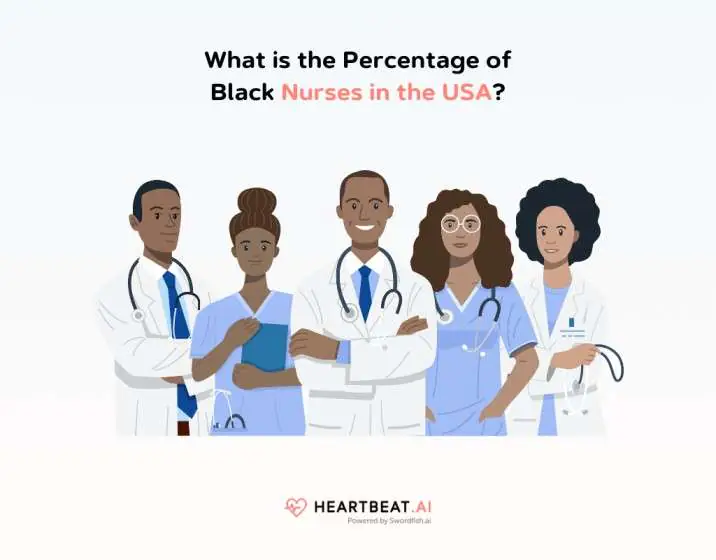
The percentage of Black nurses in the USA is approximately 10%, reflecting the increasing diversity within the healthcare workforce. This demographic shift brings unique perspectives and strengths to the field, contributing to improved patient care and cultural competence.
This percentage is an important aspect of healthcare diversity and reflects the ongoing efforts to create a more inclusive nursing profession.
The representation of Black nurses in healthcare is significant, as it contributes to culturally competent care and helps address health disparities in underserved communities.
Organizations and institutions have taken proactive steps to enhance nursing diversity. They’ve implemented initiatives like scholarships, mentorship programs, and outreach efforts to attract individuals from underrepresented backgrounds to the field.
What is the Average Salary of Nurses?
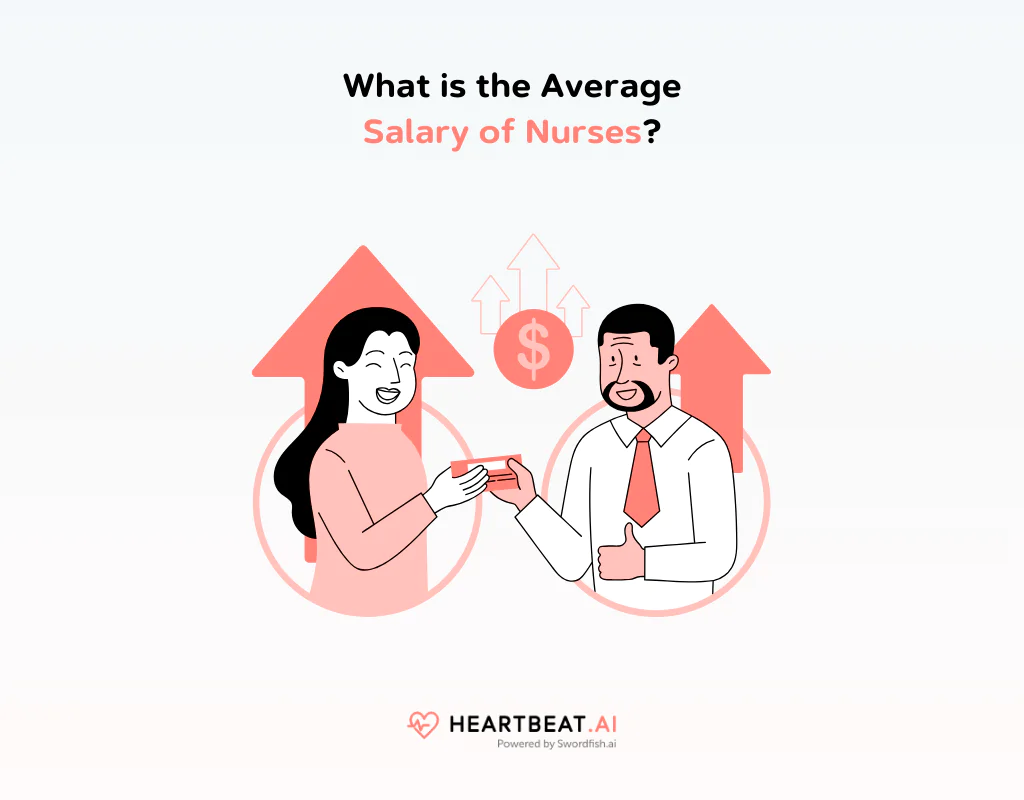
The average salary of nurses in the USA varies depending on factors like experience, location, and specialization. However, as of 2022, the median annual wage for registered nurses was approximately $75,330, reflecting the competitive earning potential in the nursing profession.
However, this figure can range from approximately $55,120 for the lowest 10% of earners to over $116,230 for the highest 10%.
Nurses who have higher degrees or specialized certifications often demand higher salaries. Nurse practitioners, for example, often earn a median income of over $117,670.
Additionally, geographic location plays a significant role in salary discrepancies, with metropolitan areas generally offering higher wages to compensate for the cost of living.
Overall, the nursing profession provides diverse salary prospects, making it a financially rewarding career for those who invest in education and gain experience.
Find the Contact List of the Best Nurses in the USA
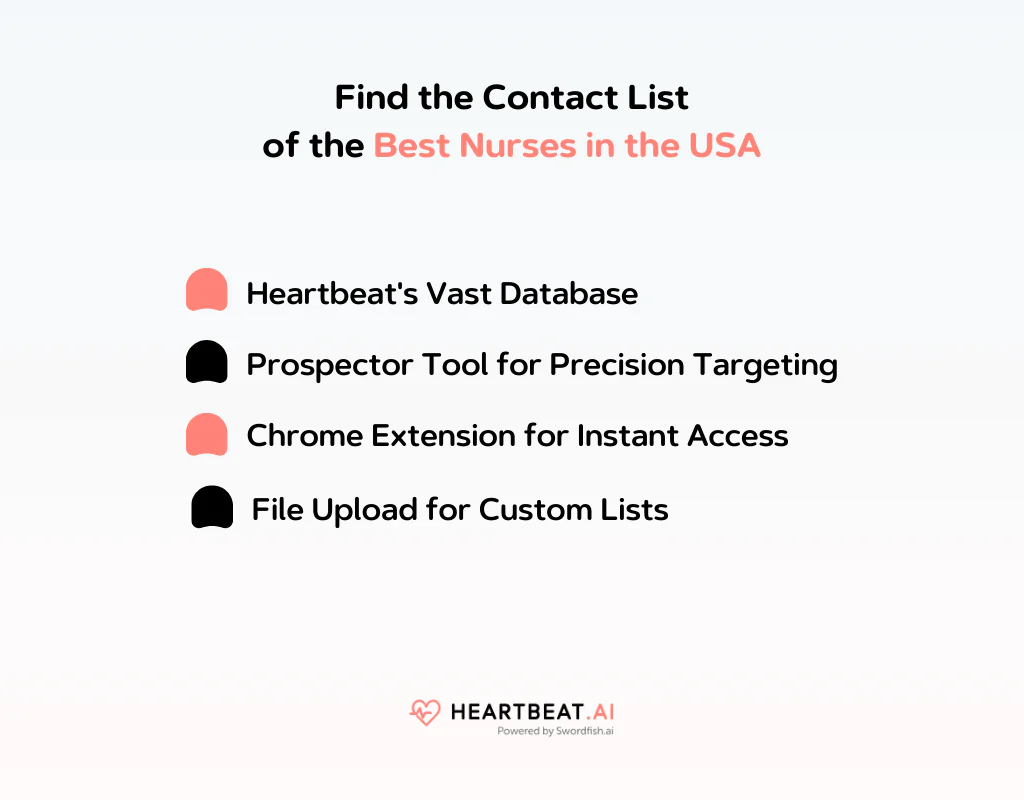
If you’re on the search for the contact list of the best nurses in the USA, Heartbeat AI is your go-to tool. With its vast database and innovative features, finding top nursing professionals is simpler and more efficient than ever before. Here’s how Heartbeat AI can help you in this search.
Heartbeat’s Vast Database
Heartbeat AI has a massive database, filled with information on healthcare professionals across the country, including 5,800,000 nurses. This means you have access to a wide pool of qualified candidates. Whether you’re looking for specialized nurses or general practitioners, the database has got you covered.
Prospector Tool for Precision Targeting
The Prospector tool in Heartbeat AI is designed to simplify your search. It allows you to set specific criteria such as location, specialization, and experience level. This way, you get a customized list of nurse contacts that match exactly what you’re looking for. It’s direct, it’s efficient, and it saves you a ton of time.
Chrome Extension for Instant Access
Heartbeat AI’s Chrome Extension adds another layer of convenience. While you’re browsing through online registries or healthcare platforms, the extension can instantly provide you with detailed contact information of nurses you come across. Just a click, and you have what you need, right there in your browser.
File Upload for Custom Lists
Do you have a list of potential candidates but lack their contact details? Heartbeat’s file upload feature comes to the rescue. Simply upload your file, and the tool fills in the missing information like email addresses and phone numbers. It’s a quick way to complete your contact list without manually searching for each entry.
Conclusion
To sum it up, our guide to nurse demographics 2024 has revealed vital information about the nursing workforce. We’ve explored the numbers behind the profession, understanding the diversity, age distribution, and more. These insights provide a snapshot of where nursing stands today.
As we move forward, this knowledge will be invaluable for healthcare planning and ensuring the nursing field continues to evolve to meet the needs of our communities.
Frequently Asked Question
Are there regional variations in nursing demographics?
Yes, nurse demographics can vary by region, with some areas having a higher concentration of nurses than others.
How has the racial and ethnic diversity of nurses changed over time?
The nursing profession has become more diverse over the years, with increasing numbers of nurses from various racial and ethnic backgrounds.
How can nursing statistics data inform healthcare planning?
Nurse demographic data can assist healthcare organizations in planning for the future. It does this by identifying potential shortages, addressing diversity and inclusion, and ensuring a skilled nursing workforce to meet evolving healthcare needs.

